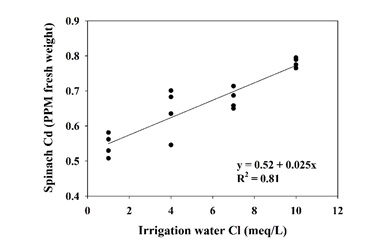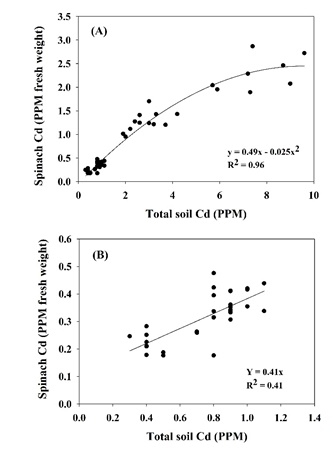The factors controlling cadmium (Cd) uptake by leafy greens, particularly spinach, have been the focus of intensive study since 2014. By far the largest influence is the soil test Cd level (Fig. 1A). Coastal soils vary from in total Cd content from less than 0.5 PPM to more than 8 PPM; across this range spinach Cd concentration varies by at least a factor of 10. This is the reason why spinach should not be grown on soils of very high Cd content, at least not without some remediation effort to reduce Cd uptake by the crop. However, if one looks at the relationship between soil and spinach Cd concentrations over a narrower range of soil Cd content it becomes clear that factors other than soil Cd content affect spinach Cd uptake (Fig. 1B). Among those factors is the concentration of chloride (Cl) in the soil.
In soils of neutral to alkaline pH like those of coastal California, much of the Cd in the soil is precipitated in compounds of low solubility, or adsorbed on the surface of soil minerals; this reduces the plant availability of soil Cd. Chloride has been shown to enhance the solubility (and therefore, the plant availability) of soil Cd; in this regard Cl is different from the other common anions in the soil (sulfate or nitrate). The main factors governing the amount of Cl in soil are the Cl concentration of irrigation water, and the degree of leaching for salinity control.
To determine how significant an influence soil Cl can be on spinach Cd uptake a pot trial was conducted in 2016. A loam soil with a total Cd content of 1.5 PPM was used. Large pots containing approximately 7 pounds of soil were seeded with ‘Tambourine' spinach seed. Different Cl treatments were imposed by watering the pots with one of four levels of irrigation water Cl concentration. The irrigation water Cl concentrations evaluated were 1, 4, 7 and 10 milliequivalents per liter (meq/L), equal to approximately 35, 140, 250 and 360 PPM Cl. For context, irrigation water on the central coast typically ranges between 1-7 meq/L, occasionally higher. These solutions were made by adding Cl to a low Cl concentration water. A mixture of sodium and calcium chloride was used to maintain a reasonable cation balance. All pots were germinated with the low Cl water, with the different Cl treatments beginning 7 days after seeding. Watering was controlled to ensure at least 10% of applied water leached from the pots, to maintain a relatively constant soil Cl concentration over the trial period. The spinach was allowed to grow for approximately a month, and then the entire vegetative biomass was harvested, oven-dried, ground and analyzed for Cd concentration. The experimental design of the trial was a randomized complete block, with 4 replicate pots per irrigation Cl treatment.
Spinach Cd concentration increased linearly with increasing irrigation water Cl concentration (Fig. 2). The slope of the regression line showed that each meq/L increase in irrigation water Cl corresponded to a 0.025 PPM increase in fresh tissue Cd concentration. This suggested that irrigation water quality can be a potentially significant factor in spinach Cl uptake. All other factors being equal, a field irrigated with water containing 7 meq/L Cl (250 PPM) may produce spinach with a Cd concentration more than 25% higher than if lower Cl irrigation water was used. These results may actually understate the effect of Cl. In this trial all treatments were germinated with low Cl water, meaning that the initial Cl status of the soil was low across treatments; it may have been well into the growth cycle before soil Cl concentrations fully reflected the treatment differences. In a commercial field situation, irrigating with high Cl water would set a baseline of soil Cl concentration at a relatively high level, affecting the crop from germination onward.
We realize that growers often do not have a choice of irrigation wells to use on a particular field. Where a choice of irrigation water exists, using the lower Cl water would minimize spinach Cd uptake. More broadly, it seems appropriate to use irrigation water Cl concentration as one factor in the determination of which fields to use for spinach production.

